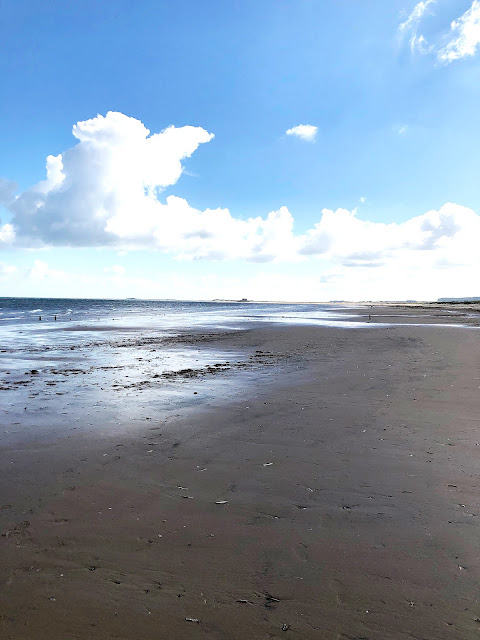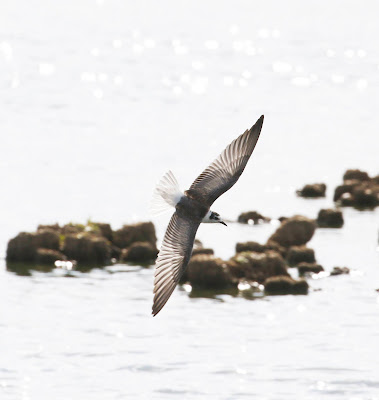Mark and myself agreed on a day out birding.It did not matter where and it did not matter if there was nothing rare or unusual to go and see. We wanted to get out of our respective houses and immerse ourselves in nature.
We decided on Norfolk as, no matter what, there are always birds to see there. For me it would be a pleasure to forget about the unforgiving concrete of Farmoor Reservoir for a day and indulge myself in the delights of Nelson's County.
I arranged to meet Mark, as we usually do, at Little Paxton in Cambridgeshire at 7.30am. From here we drove in Mark's car to Titchwell RSPB on the North Norfolk coast, arriving in pleasant sunshine at the reasonably early hour of 9am, planning to beat the weekend crowds which would inevitably arrive later at this popular reserve.
Negotiating the one way directions that the RSPB have installed at the reserve and listening to instructions from enthusiastic volunteers about face masks and filling out contact details while receiving information about the new etiquette in those hides that were open, was a bit irksome but it has to be done for all our safety.
Finally we were free to go onto the reserve and commence birding.
A visit to an empty Island Hide proved disappointingly unproductive as all the waders, which are usually close to the hide, were far out on the lagoon.Through my scope I could see ranks of Bar tailed Godwits and Knot, some of the latter still in summer plumage, roosting in the shallow water, while feeding Dunlin scurried along the mud in front of them. I was looking for something more unusual amongst the Dunlin, such as a Little Stint or Curlew Sandpiper and was delighted to discover three juvenile Curlew Sandpipers. Sadly there was no Little Stint.
Five late Swifts scythed their high speed way along and over the distant dunes. I always feel a touch of melancholy when I see them leaving, as Summer for me is at an end when the Swifts go.
Mark suggested we head further out on the reserve, right out to the beach in fact, where there would undoubtedly be some waders feeding along the shoreline. We passed and said hello to the bird artist James McCallum, crouched on the bank by the busy footpath, sketching the Curlew Sandpipers. Looking over his shoulder I could see he had almost completed a superb study of the Curlew Sandpipers.
When we got to the beach we discovered the tide was only just receding so the waders, if present, would be relatively close and being comparatively early there were only a few other people on the beach, birders and photographers mainly, so the waders would, to a greater extent, be undisturbed
We discovered, as we had hoped, that there were indeed many waders here this morning. The most obvious were diminutive Sanderling, all juveniles as far as I could see, with beautiful spangled grey and black upperparts, their white underparts gleaming in the sun while larger, chunkier Knot, again all juveniles, accompanied them.
 |
| Juvenile Sanderling |
 |
| Juvenile Knot |
 |
| Juvenile Knot |
 |
| Juvenile Sanderling |
Soon we were looking at Sanderling and Knot coming very close to us as they examined the shells and other natural detritus on the beach. Juvenile Sanderling are quite exquisite, their underparts shining white, enhanced by reflection from the flashes left on the damp sand by the receding seawater.
 |
| Juvenile Sanderling |
 |
| Juvenile Knot |
I felt my spirit become elevated by the joy I took in this simple pleasure of sitting on a wild windswept beach with small wading birds running around and before me.
 |
| Titchwell Beach |
In the end I put the camera down and indulged in a period of reflection as I sat on this expansive, sun soaked and windswept beach looking out to sea. All I needed at this very moment, was before me, as I gazed out to sea and that forever distant horizon that promises so much. Will I ever cross it again? I do hope so.
The tide slowly receded as did the waders, following the retreating surf on the shoreline.The roosting Knot on the reserve's lagoons. roused by some unknown signal, commenced returning to the beach in small flocks to feed with those already there.
 |
| Knot |
Before we left for Norfolk we had noted there was a juvenile White winged Black Tern at Cantley Beet Factory, an hour and a half's drive away at the eastern end of Norfolk. Mark keeps a list of birds he has seen in Norfolk and the tern was not on it so it was decided that this is where we would go.
I have been to Cantley Beet Factory once before to see a Water Pipit but it was to be a new experience for Mark and after a long drive we duly arrived at the factory, which from a birder's point of view provides an area of enticing shallow lagoons beyond the working industrial complex of the factory.
We signed in at the gate, were given a pass and told where to drive and park to get to the lagoons. It was then a half mile walk from the parked car, passing alongside the River Yare, to get to the particular lagoon where the tern was to be found.
 |
| The Lagoon with the factory in the background |
 |
| Juvenile White winged Black Tern |
However there came an unexpected bonus in the form and presence of more wading birds, which came to occupy our attention just as much as the tern. Cantley is renowned for attracting migrating waders and we were not to be disappointed today. We were sat on a bank in one corner of the lagoon and just to our right was a small, reed fringed muddy margin forming a small bay, that was much favoured by half a dozen wading birds. Two were my absolute favourites, a Curlew Sandpiper and a Wood Sandpiper, both juveniles and both ridiculously confiding, coming to within metres of us and showing no signs of concern at our presence whatsoever.
 |
| Juvenile Curlew Sandpiper |
 |
| Juvenile Wood Sandpiper |
 |
| Juvenile Wood Sandpiper and juvenile Ruff |
 |
| Juvenile Ruff |
 |
| Curlew Sandpiper, Wood Sandpiper and Dunlin |
Such is birding. Highs and lows can come and go and you can never know what to expect. That is more than half the fun of it.
Sad to relate, the White winged Black Tern was found dead on Monday 7th September









































No comments:
Post a Comment